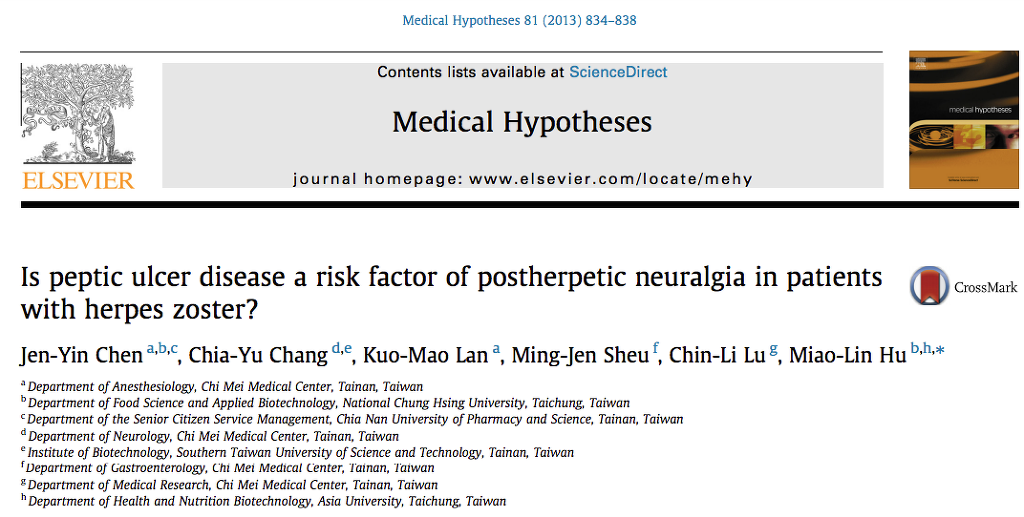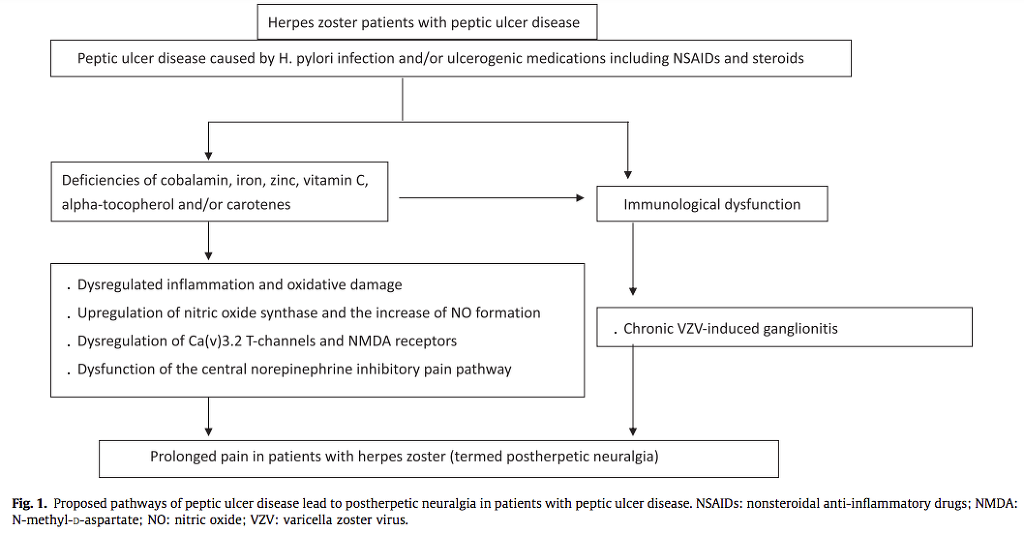Re:Is peptic ulcer disease a risk factor of postherpetic neuralgia in patients with herpes zoster?
작성자문형철작성시간20.05.21조회수379 목록 댓글 0beyond reason
![]() Is peptic ulcer disease a risk factor of postherpetic neuralgia in patients with herpes zoster
Is peptic ulcer disease a risk factor of postherpetic neuralgia in patients with herpes zoster
Abstract
Postherpetic neuralgia is the most common complication of herpes zoster which is caused by a reactivation of latent varicella zoster virus. The pathogenesis of postherpetic neuralgia may involve peripheral and central mechanisms. Reported risk factors for postherpetic neuralgia include female gender, old age, diminished cell-mediated immunity and nutritional deficiencies.
Based on our clinical observation which revealed that peptic ulcer disease (PUD) is one of the common comorbidities in patients with postherpetic neuralgia, we hypothesize that herpes zoster patients with PUD may be at a greater risk for the development of postherpetic neuralgia due to their impaired cellular immunity and depressed nutritional status.
Major causes of PUD include Helicobacter pylori infection and usage of ulcerogenic medications. Patients with H. pylori infection may develop T cell dysfunctions and nutritional deficiencies including vitamin C, iron, cobalamin, carotenes and alpha-tocopherol. Ulcerogenic medications such as nonsteroidal anti-inflammatory drugs and steroids have been found not only to be ulcerogenic but also immunosuppressive to T cells. In addition, usage of steroids and nonsteroidal anti-inflammatory drugs may cause deficiencies of alpha-tocopherol, carotenes, cobalamin, iron, zinc and vitamin C.
Vitamin C, carotenes and alpha-tocopherol are anti-inflammatory and the major oxidant scavengers in the aqua phase and biomembranes. Deficiencies of these nutrients may induce dysregulated inflammation and oxidative damage leading to neuropathic pain in patients with herpes zoster.
Furthermore, nutrient deficiencies including zinc, iron, cobalamin and vitamin C are associated with dysregulation of Ca(v)3.2 T-channels and N-methyl-D-aspartate receptors, upregulation of nitric oxide synthase, the increase of nitric oxide formation and dysfunction of central norepinephrine inhibitory pain pathway. Prospective cohort studies are suggested to test the hypothesis. We further propose that a follow-up study that contains two groups of herpes zoster patients, i.e., with or without gastroendoscopy-proven PUD, be conducted to determine their incidence of postherpetic neuralgia. In addition, despite of the high proportion of zoster patients having been treated with antiviral therapies, prevention and treatment of postherpetic neuralgia remain challenging in clinical practice. The potential risk of postherpetic neuralgia in zoster patients with PUD could mean that physicians need to pay more attention to the comorbidity--PUD in patients with herpes zoster and treat PUD earlier in order to prevent the development of postherpetic neuralgia.

